Another exciting afternoon racing robots with friends. 😉
Taken by @vnsavitri



Taken by Ricky

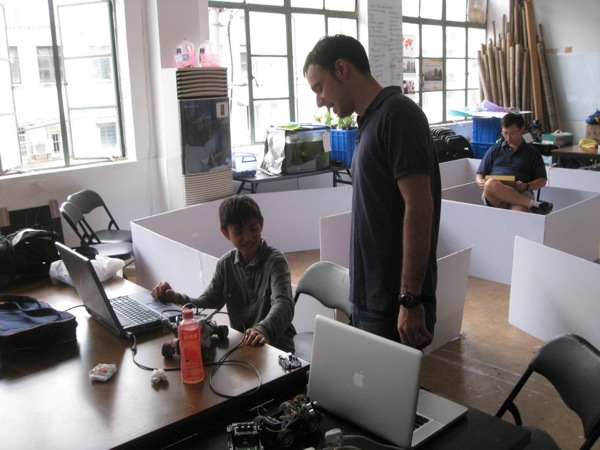

 ]]>
]]>
September 26th, 2011 § 0 comments § permalink
July 11th, 2011 § 0 comments § permalink
比赛赢家: Nelson Zhang (自主瓦力) and Michael Liao (遥控坦克)非常感谢 盛大创新院 赞助了2台电子书做为奖品!

感谢参赛者们的努力,你们是最棒的! 感谢盛大创新院慷慨的赞助! 感谢 TimeOut 杂志 报道这次的活动!感谢DFRobot 和 RoboticFans 参与(尤其是叶琛和Rocky)这次活动的筹备!感谢新单位帮忙做宣传!感谢昨天来围观的朋友们! 感谢那些没办法过来但是给我们精神支持的朋友们!感谢Andi 设计制作这次的活动海报与传单!感谢Paul 赞助海报印刷!感谢Bindy 帮忙翻译和贩卖饮料!感谢Michael 捐赠赢得的电子书作为下次的奖品和请参赛者们和饮料!感谢John 帮忙活动的筹备!感谢Airie 帮忙在人人网上做宣传!感谢旻琳负责整个活动的宣传、协调与筹备!感谢我们零距离家长论坛的j家长和孩子们的参观!
下一次的比赛预计会在8月底举办,敬请期待!
]]>July 8th, 2011 § 0 comments § permalink
 欢迎有兴趣的朋友来围观!这里报名。
比赛分为两个部分:
* 自动控制组
* 遥控组
==>比赛细则<==
如果你的机器车也想参加比赛,请写邮件到: [email protected]
有兴趣赞助这个比赛请写邮件到:[email protected]
这里有上次的车赛花絮.
已报名的队伍:
Team 1: Lauren Pan (Toy car modification robot)
Team 2: Barry Xu (DIY robot)
Team 3: Daniel (2WD Mobile robot kit)
Team 4: Zhang Chen (Andriod control HCR)
Team 5: Jiang Gui Long/Wu Tao/Zhang Jie ( Android Control HCR)
Team 6: Rockets (Tank mobile robot)
Team 7: Unknown (LEGO mobile robot)
Team 8: Ricky Ye (HCR robot)
Team 9: Ricky Ng-Adam (Autonomous robot toy car – ART)
Team 10: Lutz Michaelis (Autonomous Beetleduino)
Team 11: Paul Adams (Hoverbot Hubert)
Team 12: Nelson Zhang (Autonomous Wall-E)
Team 13: Lionello Lunesu (LEGO mobile robot)
Team 14: David Li (Soccerbot)
]]>
欢迎有兴趣的朋友来围观!这里报名。
比赛分为两个部分:
* 自动控制组
* 遥控组
==>比赛细则<==
如果你的机器车也想参加比赛,请写邮件到: [email protected]
有兴趣赞助这个比赛请写邮件到:[email protected]
这里有上次的车赛花絮.
已报名的队伍:
Team 1: Lauren Pan (Toy car modification robot)
Team 2: Barry Xu (DIY robot)
Team 3: Daniel (2WD Mobile robot kit)
Team 4: Zhang Chen (Andriod control HCR)
Team 5: Jiang Gui Long/Wu Tao/Zhang Jie ( Android Control HCR)
Team 6: Rockets (Tank mobile robot)
Team 7: Unknown (LEGO mobile robot)
Team 8: Ricky Ye (HCR robot)
Team 9: Ricky Ng-Adam (Autonomous robot toy car – ART)
Team 10: Lutz Michaelis (Autonomous Beetleduino)
Team 11: Paul Adams (Hoverbot Hubert)
Team 12: Nelson Zhang (Autonomous Wall-E)
Team 13: Lionello Lunesu (LEGO mobile robot)
Team 14: David Li (Soccerbot)
]]>
June 8th, 2011 § 1 comment § permalink
Android Open Accessory Development Kit.
Android3.1平台(也向下移植到了Android2.3.4)引进了Android Open Accessory support,这使得外部USB硬件(An Android USB accessory)能够与Android设备在一个特殊的“accessory”模式下互相通信。当一个Android设备在这个accessory模式下时,接入的硬件作为一个USB host(为总线供电以及枚举设备),而Android设备作为一个USB设备来使用。Android USB附件是特别设计的,用以附加在支持Android平台的硬件设备上并且遵守一个简单的附件协议(Android accessory protocol)使他们能够侦测支持附件模式的Android硬件设备。工作坊是每周举行的(目前是英语教学)。我们将探索包括开发Android软件部分和单片机部分,涉及到的方面包括机器人的机械,电子以及软件工程学。 特别的,我们将一起研究那些兼容ADK的硬件开发板,比如Google IOIO board和Seeedstudio提供的新硬件。 付费的新车间会员可以免费参加。非会员需要支付50元/次。 更多的信息请查看“Android & Robots” wiki. 不要忘了做好准备工作以及加入我们的[email protected] mailing list!注意,这是一个需要大家合作的讨论会,我们希望每个人都能积极的参与和贡献自己的力量。 ]]>
May 25th, 2011 § 2 comments § permalink
May 9th, 2011 § 1 comment § permalink
周日的虫虫工作坊有13人参与,10个小朋友加上家长,很热闹,很愉快的周日下午!
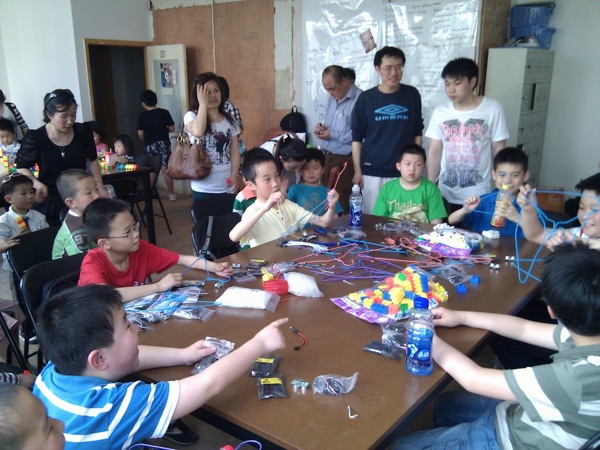
May 6th, 2011 § 0 comments § permalink
遥控小车的改造 May 3rd, 2011
今天完成了遥控车的改造,这是自主控制的第一步。这辆车是在淘宝上买的,结构很简单,控制很简陋。方向就是将电机打死,这时候电流会非常大,而且对于将来的自主移动的精细控制带来不利因素。所以很早就想把它改成舵机控制的了,下面就是整个改造的过程。
这就是需要改造的部分。

先将需要改造的部分画下来,便于设计框架结构。我不是机械出身的,所以就画个大概吧。
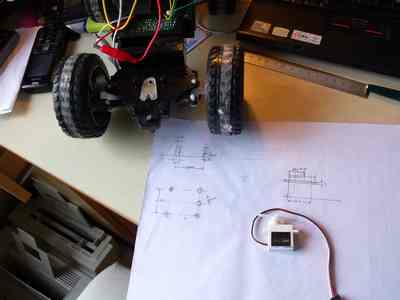
结构图完成
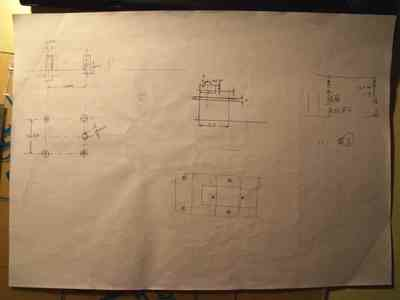
在图纸上设计新的结构
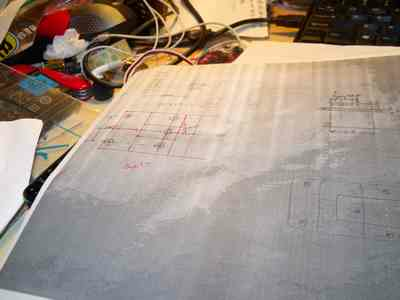
根据设计切割材料
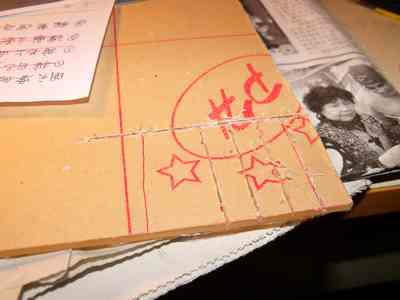
最后完成的样子,由于是临时电路,也就没固定,看上去有点像垃圾车-_-b
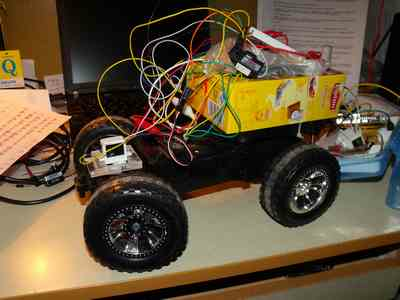
改造部分的特写
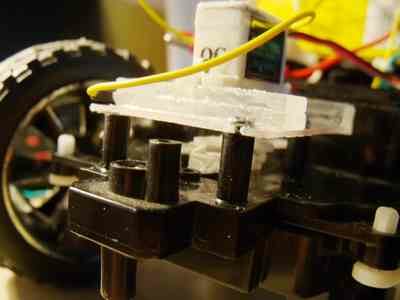
再来一张
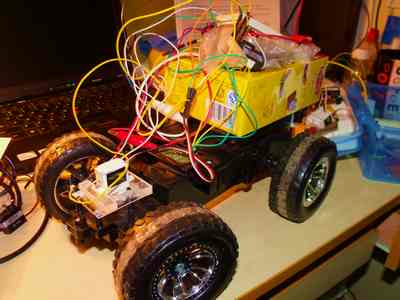
这些只是机械部份,然后就是控制部份。由于舵机能够转动的角度范围到180度,而该车的转向轮仅能转动在30-40度之间。同时,自主移动机器人目标是在Arduino上面开发。所以我就一步到位,先用Arduino读取天地飞的pwm信号,然后经过转换,输出新的pwm信号给舵机,这样就不会因为卡住而损坏舵机了。
最后效果如下
http://v.youku.com/v_show/id_XMjYzOTc2NzA4.html
使用的程序非常简单,如下:
#include <Servo.h>
//Author: HE Qichen
//Date: 2011-5-3
//Website: http://gaishi.vicp.net
//Email: heqichen(a)gaishi.vicp.net
Servo directionServo;
void setup()
{
pinMode(2, INPUT);
directionServo.attach(3);
}
void loop()
{
int t, a;
t = pulseIn(2, HIGH);
a = map(t, 1000, 2000, 65, 115);
directionServo.write(a);
}
]]>
May 6th, 2011 § 1 comment § permalink
Arduino读取g-sensor数据 May 2nd, 2011
在四轴飞行器上除了要有陀螺仪外,还要有个重要的传感器就是重力传感器。由于它们各自的误差,若使用单一的传感器会造成严重的精读问题,使飞行器丧失稳定性。所以要用两个传感器进行相互矫正。
现在重力传感器应用非常广,目前iphone等智能手机上都有重力传感器,包括笔者的一台山寨手机上都有重力传感器。
这次就是要用Android来读取重力传感器的数据。这个重力传感器模块是从淘宝购买的,模块非常简单,自己够买芯片来焊接也不成问题。根据它的datasheet,就能够知道如何使用这款重力加速度模块了。下面就进行详细的介绍
这个模块使用的芯片型号是MMA7260Q,(datasheet下载[PDF,229KB]),测试中的电路就是下面图片中的样子
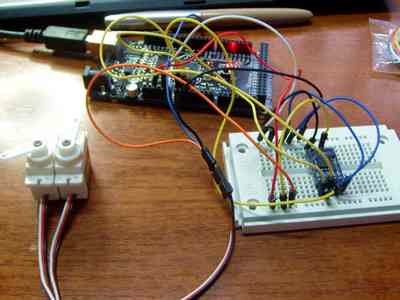
控制的目标是通过重力传感器的数据来控制舵机的转动。但是发现会有少量的抖动,于是在程序中加入了一个简单的滤波器,阶数没有仔细调,但是基本上能够进行控制了。
http://v.youku.com/v_show/id_XMjYzNjIyODIw.html
下面是芯片的特写
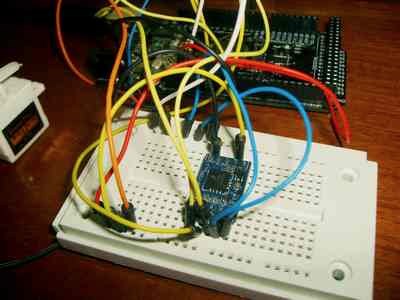
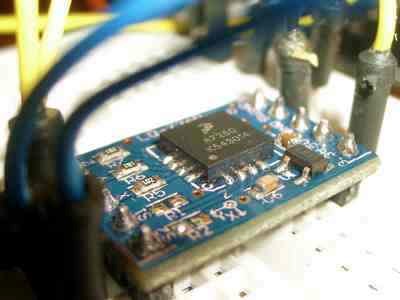
下面是用到的代码
#include <Servo.h>
//Author: HE Qichen
//Email: heqichen(a)gaishi.vicp.net
//Website: http://gaishi.vicp.net
//Date: 2011-5-2
#define FILTER_LEVEL 3
class Filter
{
private:
int buffer[FILTER_LEVEL];
public:
Filter()
{
int i;
for (i=0; i<FILTER_LEVEL; ++i)
{
buffer[i] = 0;
}
}
int filter(int value)
{
int i;
int sum;
for (i=0; i<FILTER_LEVEL-1; ++i)
{
buffer[i] = buffer[i+1];
}
buffer[FILTER_LEVEL-1] = value;
sum = 0;
for (i=0; i<FILTER_LEVEL; ++i)
{
sum += buffer[i];
}
return sum / FILTER_LEVEL;
}
};
Servo testServo;
Filter xFilter, yFilter, zFilter;
void setup()
{
Serial.begin(9600);
testServo.attach(2);
}
void loop()
{
int gx, gy, gz;
gx = analogRead(A0);
gy = analogRead(A1);
gz = analogRead(A2);
Serial.print("x: ");
Serial.print(gx, DEC);
Serial.print(" y: ");
Serial.print(gy, DEC);
Serial.print(" z: ");
Serial.println(gz, DEC);
int fgx, fgy, fgz;
fgx = xFilter.filter(gx);
fgy = yFilter.filter(gy);
fgz = zFilter.filter(gz);
Serial.print(" fx: ");
Serial.print(fgx, DEC);
Serial.print(" fy: ");
Serial.print(fgy, DEC);
Serial.print(" fz: ");
Serial.println(fgz, DEC);
testServo.write((fgz-100)/3);
//delay(10);
}
]]>
May 6th, 2011 § 0 comments § permalink
嵌入之梦-圆梦小车开发 May 1st, 2011
今天看到一台嵌入之梦的小车,但是上电之后发了疯似的乱跑,所以刷之。但新车间却没有网络,没办法,自己一点一点试。。结果如下
CT1 接受pwm,控制速度 CT2 前进控制信号,高电位转动 CT3 后退控制信号,高电位转动
但是由于小车上的UNO与我的Ubuntu连接有问题,貌似只有Windows是好的,Mac OS有时也会出问题。所以最后车上改用了Mega 1280。
但是又发现一个问题,就是Arduino使用USB供电的时候很正常,然而,使用车上接出来的5V电源时,程序就会混乱,完全没有一点规律。猜测可能是由于电机转动导致整个系统的电压下降,无法提供足够的电压给Arduino的板子上。这大概也是之前uno不会发疯的原因。没办法,在小车上再接一块9V层叠式电池,作为Arduino的电源。最后终于行了。
后面程序的作用是往前走,遇到前方有物体是后退,打弯,然后继续往前,一个简单的壁障程序。没有用到速度控制。下面就是这个小车最后的样子,手机拍的,将就看吧
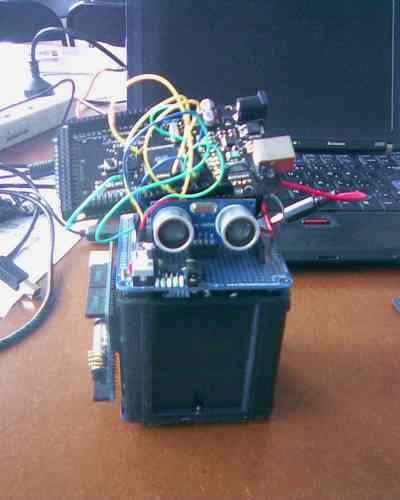
左侧照
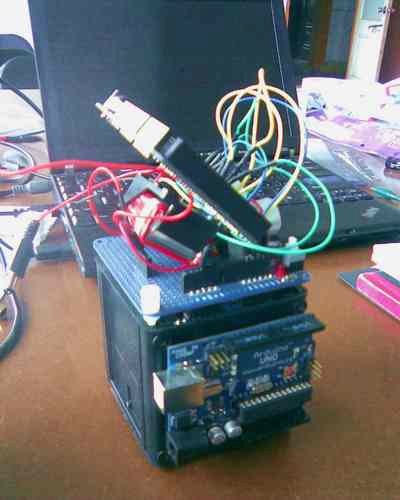
右侧照
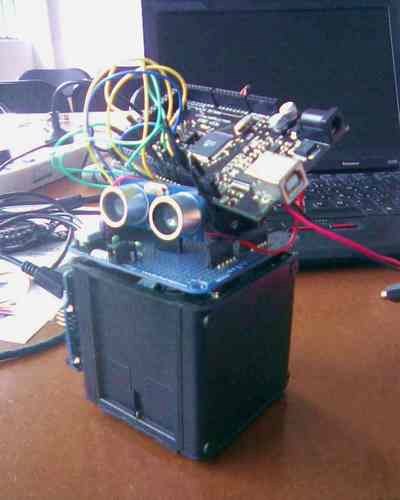
再来一张
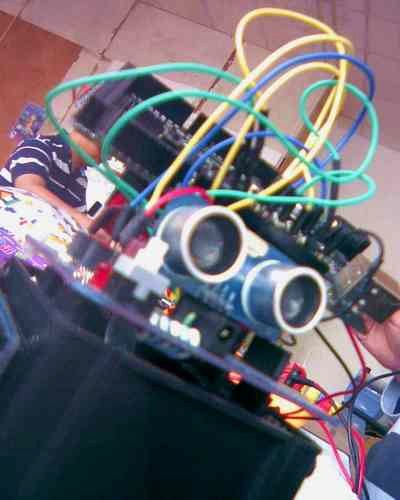 http://v.youku.com/v_show/id_XMjYzMzY0NzA0.html
http://v.youku.com/v_show/id_XMjYzMzY0NzA0.html
用到的程序就是下面的
//Author: HE Qichen
//Email: heqichen(a)gaishi.vicp.net
//Website: http://gaishi.vicp.net
//Date: 2011-5-1
int status;
#define LEFT_SPEED 6
#define LEFT_FORWARD 7
#define LEFT_BACKWARD 8
#define RIGHT_SPEED 10
#define RIGHT_FORWARD 11
#define RIGHT_BACKWARD 12
#define ULTRASONIC_ECHO 3
#define ULTRASONIC_TRIG 4
#define NORMAL_SPEED 100
#define STOP_SPEED 0
void setup()
{
Serial.begin(9600);
setupMove();
setupUltrasonic();
}
void loop()
{
unsigned int d;
moveForward();
d = readDistance();
Serial.println(d, DEC);
if (d < 700)
{
moveBackward();
delay(500);
turnLeft();
delay(200);
}
}
void moveForward()
{
analogWrite(LEFT_SPEED, NORMAL_SPEED);
digitalWrite(LEFT_BACKWARD, LOW);
digitalWrite(LEFT_FORWARD, HIGH);
analogWrite(RIGHT_SPEED, NORMAL_SPEED);
digitalWrite(RIGHT_BACKWARD, LOW);
digitalWrite(RIGHT_FORWARD, HIGH);
}
void moveBackward()
{
analogWrite(LEFT_SPEED, NORMAL_SPEED);
digitalWrite(LEFT_BACKWARD, HIGH);
digitalWrite(LEFT_FORWARD, LOW);
analogWrite(RIGHT_SPEED, NORMAL_SPEED);
digitalWrite(RIGHT_BACKWARD, HIGH);
digitalWrite(RIGHT_FORWARD, LOW);
}
void turnLeft()
{
analogWrite(LEFT_SPEED, NORMAL_SPEED);
digitalWrite(LEFT_BACKWARD, HIGH);
digitalWrite(LEFT_FORWARD, LOW);
analogWrite(RIGHT_SPEED, NORMAL_SPEED);
digitalWrite(RIGHT_BACKWARD, LOW);
digitalWrite(RIGHT_FORWARD, HIGH);
}
void turnRight()
{
analogWrite(LEFT_SPEED, NORMAL_SPEED);
digitalWrite(LEFT_BACKWARD, LOW);
digitalWrite(LEFT_FORWARD, HIGH);
analogWrite(RIGHT_SPEED, NORMAL_SPEED);
digitalWrite(RIGHT_BACKWARD, HIGH);
digitalWrite(RIGHT_FORWARD, LOW);
}
void moveStop()
{
analogWrite(LEFT_SPEED, STOP_SPEED);
digitalWrite(LEFT_BACKWARD, LOW);
digitalWrite(LEFT_FORWARD, LOW);
analogWrite(RIGHT_SPEED, STOP_SPEED);
digitalWrite(RIGHT_BACKWARD, LOW);
digitalWrite(RIGHT_FORWARD, LOW);
}
void setupMove()
{
pinMode(LEFT_SPEED, OUTPUT);
pinMode(LEFT_FORWARD, OUTPUT);
pinMode(LEFT_BACKWARD, OUTPUT);
pinMode(RIGHT_SPEED, OUTPUT);
pinMode(RIGHT_FORWARD, OUTPUT);
pinMode(RIGHT_BACKWARD, OUTPUT);
analogWrite(LEFT_SPEED, STOP_SPEED);
digitalWrite(LEFT_FORWARD, LOW);
digitalWrite(LEFT_BACKWARD, LOW);
analogWrite(RIGHT_SPEED, STOP_SPEED);
digitalWrite(RIGHT_FORWARD, LOW);
digitalWrite(RIGHT_BACKWARD, LOW);
}
unsigned int readDistance()
{
int duration;
digitalWrite(ULTRASONIC_TRIG, LOW);
delayMicroseconds(2);
digitalWrite(ULTRASONIC_TRIG, HIGH);
delayMicroseconds(5);
digitalWrite(ULTRASONIC_TRIG, LOW);
// The same pin is used to read the signal from the PING))): a HIGH
// pulse whose duration is the time (in microseconds) from the sending
// of the ping to the reception of its echo off of an object.
duration = pulseIn(ULTRASONIC_ECHO, HIGH);
return duration;
}
void setupUltrasonic()
{
pinMode(ULTRASONIC_TRIG, OUTPUT);
pinMode(ULTRASONIC_ECHO, INPUT);
digitalWrite(ULTRASONIC_TRIG, LOW);
}
]]>
April 30th, 2011 § 0 comments § permalink
Ricky just make an update on his quest to streaming video from Android.
element14: XinCheJian GGHC: XinCheJian coming out of the depths of video streaming from Android!: “”
]]>